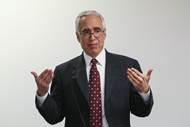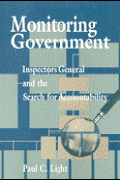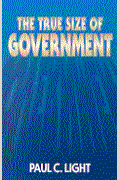Whether one sees confidence as a glass half full or half empty, the agenda for either sustaining or increasing confidence is the same. The sector must do better at explaining itself to the American people, defending itself against unwarranted criticism, measuring its performance in achieving results, and addressing poor performance in its midst.
Unfortunately, the charitable sector has traditionally shown little interest in the ebb and flow of confidence. It has long assumed that it has an inexhaustible reservoir of goodwill, or that occasional scandals do not affect the sector as a whole. Even the way the sector collects information on confidence suggests a lack of dollars and interest in the kind of in-depth research that might inform an aggressive strategy for increasing and sustaining high levels of confidence. Most reports, including the ones cited here, are based on a handful of questions added on to other ongoing opinion surveys (see note on methodology, p. 3).
The Effect of September 11
If there has been a decline in confidence in charitable organizations, it is clearly linked to the controversy surrounding disbursement of more than $2 billion collected by the various September 11 funds, most notably the Red Cross Liberty Fund. Americans paid a great deal of attention to the rash of stories about the difficulties disbursing funds to the victims of the tragedy. As of early December, 60 percent of Americans said they were paying “very” or “fairly” close attention to the controversy, compared to 34 percent who were paying very or fairly close attention to the stories about the Enron bankruptcy at the time.
According to Independent Sector (IS), a nonprofit coalition of charitable funders and agencies, September 11 had a negligible effect on public support for charities. According to a series of surveys conducted by Wirthlin Worldwide on behalf of IS, the number of respondents who agreed that most charities are honest and ethical in their use of funds rose from 67 percent in July 2001 to 73 percent in February 2002 before falling back to 64 percent in July. As IS wrote in August 2002, “support for nonprofits has remained fairly stable over the last decade, with the events of September 11 having had no lasting impact on the public view of American charities, and current scandals in the corporate sector having no apparent negative impact thus far.”
The IS report, which was titled Keeping the Trust, was not the last word on confidence. It was released just before two troublesome assessments.
The first assessment came from the Chronicle of Philanthropy on September 5. According to an August 2002 survey conducted by Harris Interactive on behalf of the Chronicle, 42 percent of respondents said they had lost confidence in charities because of the September 11 controversies, compared to just 19 percent who said they had gained confidence. As the Chronicle noted, “Nearly 3 in 10 of those polled said they would be less likely to contribute to all types of charities because of the way in which September 11 funds were disbursed.”
The second contrary view came from the Brookings Institution’s Center for Public Service on September 9. According to a series of surveys conducted for CPS by Princeton Survey Research Associates, the number of respondents who said they had “a lot” of confidence in charitable organizations fell from 25 percent in July 2001 to 18 percent in May, while the number who said they had no confidence at all doubled, from 8 percent to 17 percent. Although the number of Americans who said they had “some” confidence remained statistically unchanged (ranging between 65 percent and 62 percent during the period), CPS concluded that the data showed an erosion of support.
Confidence in federated appeals such as the United Way also appears to have fallen significantly between July 2001 and December. When asked in the July 2001 IS survey about their confidence in “federated appeals such as the United Way and March of Dimes,” 39 percent of respondents said they had a lot of confidence. By the December CPS survey, the number of respondents who expressed a lot of confidence in the United Way and March of Dimes had fallen to 26 percent, where it remained in September 2002. (It is important to note that the question misidentified the March of Dimes as a federated appeal, and was repeated in the CPS surveys only to establish a pre-post September 11 trend line.)
The State of Confidence in Charitable Organizations
The three reports actually came to the same conclusion about the state of confidence as the nation approached the first anniversary of September 11: regardless of the measure used, between three-fifths and three-quarters of Americans had at least some confidence in charities or charitable organizations.
The three reports also showed the same general trend: again, regardless of the measure used, confidence in charities declined over the year, albeit in relatively small increments. The CPS and IS trend lines generally fit the retrospective data collected in the Chronicle survey. If the Chronicle respondents were telling the truth, confidence in charitable organizations would have fallen by a fifth (the 42 percent who said they had lost confidence minus the 19 percent who said they had gained confidence), which is just about what happened.
However, the three reports clearly differed in interpretation: whereas IS concluded that confidence was mostly positive, CPS and the Chronicle concluded that it had fallen to a new and lower plateau.
The Effect of Question Wording
At least part of the disagreement is based on question wording. The IS respondents were asked whether they agreed or disagreed that “most charities” are honest and ethical in their use of donated funds; Chronicle respondents were asked specifically about the impact of the post-September 11 disbursement controversy on their confidence in charities; and CPS respondents were asked how much confidence they had in charitable organizations, a lot, some, or none. (The confidence question was first used by IS in the July 2001 Wirthlin survey, and was repeated in the CPS surveys to establish an exact pre-post September 11 comparison.)
Because IS respondents were asked to make a dichotomous judgment about “most charities,” rather than “all charities,” “some charities,” or “charities” in general, the measure appears to favor a more positive answer. Surely, most charities are honest and ethical even if some are not. Conversely, because Chronicle respondents were prompted to think back to the disbursement controversy, the measure appears to encourage a more negative answer. Finally, because the CPS respondents were only given three possible answers, one of which was comfortably soft and non-judgmental, the measure appears to give respondents an easy way out of making either an overly positive or negative judgment.
Put another way, respondents who took the less socially popular response in all three surveys had to mean it. The fact that a third of IS respondents disagreed that most charities were honest and ethical, and that nearly a fifth of CPS respondents reported no confidence at all in charitable organizations takes on added significance given the temptation to take the easier response.
A Test of Question Wording
Even the same question can prompt different interpretations of the state of confidence, however. Whereas CPS focuses on movement in “a lot” or “none at all” categories of confidence in charitable organizations, IS tends to combine the “a lot” or “some” categories into an overwhelmingly reassuring measure of confidence. The IS assumption is that “some” confidence is “positive” confidence. In looking back at the CPS December 2001 data in Keeping the Trust, for example, IS concluded that CPS was correct in noting the lack of movement between the sub-categories that comprise the confidence measure, but added that “with confidence levels at the 90 percent level there may not have been much room for improvement.”
However, according to a test of question wording in the September 2002 CPS survey, “some” confidence is actually a mix of positive and negative attitudes. The test involved two equal numbers of respondents. One group was asked the confidence question with three possible answers: “a lot,” “some,” or “none.” The other group was asked the same question with four possible answers: “a great deal,” “a fair amount,” “not too much,” or “none at all.” As table 2 shows, great confidence in both charitable organizations and federated appeals such as the United Way is lower when respondents are given a chance to express a wider range of opinion.
Even at these lower levels, one might argue that the charitable sector has little to worry about. However, as table 3 shows, in the context of August 2002 Gallup data on other civic institutions, the CPS data suggests that confidence in charitable organizations and federated appeals is dangerously low.
Indeed, as table 3 shows, the percentage of respondents who said they have “not too much” or no confidence at all in charitable organizations and federated appeals puts the sector well below confidence in the judicial branch, executive branch, and legislative branch, and at roughly the same level as the elected and appointed public officials who run government.
This discomfort is only heightened by the demographics of confidence. Simply put, the people most likely to be served by charitable organizations are less confident, while the people most likely to contribute money to the sector as they grow older are also less confident. On the one hand, the September 2002 survey shows a positive relationship between education, income, and confidence: 41 percent of respondents with a high school education or less reported not too much or no confidence in charitable organizations, compared to 33 percent of respondents with at least some college or more. Similarly, 44 percent of respondents with household incomes of less than $20,000 reported not too much or no confidence, compared to 30 percent of those with household incomes over $60,000. On the other hand, the survey also shows a negative relationship between age and confidence: 42 percent of respondents over the age of 45 had little or no confidence, compared to 32 percent of respondents under 45.
When the age and education/income are examined together, young, college educated Americans emerged as the most confident in charitable organizations. As table 4 shows, being young and having at least some college is a recipe for confidence, perhaps because younger Americans are less likely than older Americans to give money, while more educated Americans are less likely to need the services that many charitable organizations provide than their less educated peers.
Without further study, it is impossible to determine whether age or education/income are the primary determinants of confidence. If age is the driver, young Americans will become more cynical as they progress through the life cycle; if education and the income that rises with it is the driver, young Americans should remain more trusting over time.
Comparing Trend Lines
The question wording experiment suggests that the trend line in confidence may be more negative than previously suggested. That trend line is made more significant by the fact that respondents who had no confidence increased so dramatically against the “rally ’round” effect revealed in so many post-September 11 studies. As table 1 shows, the decline in confidence was clear and persistent. If there was any surge in confidence as measured by the CPS surveys, it was abbreviated at best.
According to the CPS trend line, confidence in charitable organizations appears to follow a different path than confidence in government, which surged overnight, stayed high throughout 2001, and faded slowly thereafter. According to the Gallup Poll, for example, 60 percent of Americans had a great deal or fair amount of confidence in the federal government to handle domestic problems just before September 11, compared to 77 percent in early October, 71 percent in February, and 63 percent in September 2002. What went up very quickly came down more slowly.
Moreover, even the oft-disparaged Congress managed to hold on to more of its gain than charities. Also according to the Gallup Poll, Congress’s approval rating doubled from 42 to 84 percent immediately after September 11, coasted downward to the low 60 percent level through late spring 2002, and was still in the low 50 percent range in mid-July when Wirthlin Worldwide conducted the IS survey. By then, confidence in charities had dropped below its pre-September 11 level. This trend line tells a story more about having and losing at least some of the trust than keeping it.
There are two unknowns in this analysis. First, neither Independent Sector nor the Center for Public Service took measures of charitable confidence immediately after September 11. It is entirely possible that confidence surged and fell dramatically between the July and December surveys. If true, the charitable sector squandered the trust it had gained. Second, it is impossible to know what happened within the vast number of respondents who continued to express “some” confidence in charitable organizations. Although it is unlikely that respondents who once said they had a lot of confidence suddenly changed to no confidence at all, one can only speculate that confidence was falling within the middle category.
It is useful to note that public confidence and wise use of funds are not the only ways of measuring the overall health of the sector. Consider two other measures drawn from a June 2002 Center for Public Service survey of 2,820 respondents—one positive and one negative:
- When asked their general opinion about the three sectors, 71 percent of the June respondents said they had a very or somewhat favorable opinion of charitable organizations, compared to 65 percent who felt the same toward businesses and just 54 percent who felt the same toward the federal government.*
- However, when asked for their best guess regarding the performance of the three workforces, respondents estimated on average that 39 percent of the people who work for charitable organizations do not perform their jobs well, compared to an estimated 42 percent of the people who work for business, and 48 percent of the people who work for the federal government.
*The total sample size for the June 2002 survey was 2,820, yielding a margin of error of plus or minus 3 percent.
Although the first number is consistent with the percentage of the IS respondents who said charities are honest and ethical, the second number suggests that Americans do not see the employees of charitable organizations as significantly different from employees of private business.
Rebuilding Confidence
Ultimately, these reports produce conflicting images of both the present and the future. Whereas IS sees a sector that “enjoys broad public support,” CPS sees a sector under continued duress. For IS, the greatest threat in current levels of confidence is the complacency that comes with overwhelming public support; for CPS, the problem is the heightened scrutiny and regulation that comes from a weakened sector.
If there is anything hopeful in this debate, however, it is that the charitable sector can confront both complacency and crisis with the same four-point agenda. As the Independent Sector rightly notes, keeping the trust requires the same vigilance as rebuilding the trust, especially if the sector wants younger Americans to continue trusting the sector into the future.
The charitable sector must mount an aggressive effort to explain itself more thoroughly to the American public. It cannot remain silent while others in the media and watchdog groups define it through unrelenting coverage of scandal and controversy. The sector must help the public understand what the nation’s 1.2 million charitable organizations do and why its 11 million employees come to work each day.
The sector must create the capacity to defend itself when it is threatened. Except for the United Way of New York City and the New York Community Trust, which worked together to educate journalists and explain their distribution plans for their September 11 Fund, the sector was mostly silent during the Red Cross controversy. The rebuttal may help explain why confidence in the United Way stabilized after a precipitous fall at the start of the controversy.
The sector and its organizations must work harder at measuring the impact of their work. The perceived performance of government agencies, such as the Internal Revenue Service and Social Security Administration, clearly matters to public confidence in government as a whole. Unfortunately, many nonprofits simply do not know how to measure their impacts on the quality of life in their communities, let alone the impact of their programmatic interventions on their clients. Yet the best, and perhaps only, way to rebut charges of waste and inefficiency is to produce valid indicators.
The sector must address poor performance wherever it exists. Defending the sector does not mean accepting failure. Nor does it mean allowing organizations to operate with second-rate technology and training. Where its organizations cannot show measurable results, the sector must either help them improve or help them close down.
Conclusion
None of these recommendations will matter if the charitable sector is unwilling to confront the decline in confidence. The sector does contain poorly performing organizations, incompetent executives, disengaged boards, and occasional malfeasance. But the vast majority of charitable organizations are working hard at doing good. It is time to tell their stories, too.
It is also time to conduct the kind of detailed assessment of confidence in the sector that would help focus the four strategies outlined above. Simply asked, what does the American public know about the nonprofit sector and how did they learn it? It is not a question that can be easily answered with a handful of questions asked every few years. Government and the private sector spend millions of dollars each year assessing confidence in their institutions and products. It is time for the nonprofit sector to start doing so as well.
The Brookings Institution is committed to quality, independence, and impact.
We are supported by a diverse array of funders. In line with our values and policies, each Brookings publication represents the sole views of its author(s).







